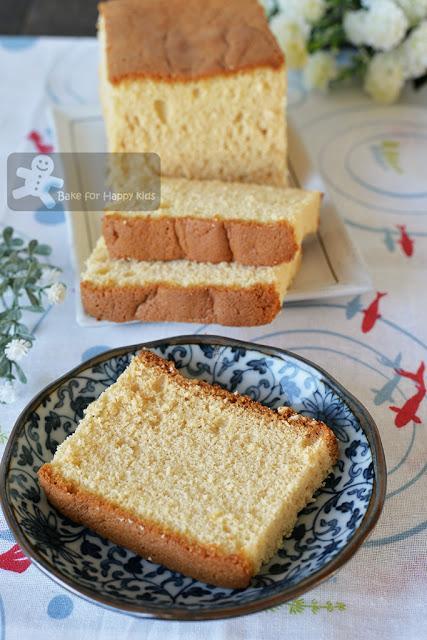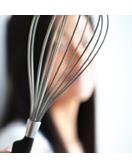And here is my episode two :)Remember my episode one at here when I started by baking the most popular and traditional Castella cake recipe from Just One Cookbook? It is the most popular recipe because it is always the first recipe that I see whenever I searched for "Castella cake recipe" at Google. I like it but it is not THE Castella cake that I'm after.
So here I like to answer my million-dollar question:
Is beating the eggs separately make the Castella cake better?
And I can tell you that my answer is YES!!!
Any evidence? Absolutely!!!
See this Castella cake...

Japanese Castella Cake / Kasutera カステラ Baked with Egg Separation Method
I baked this using the popular recipe from Just One Cookbook at here.
Same recipe.
Same ingredients.
Same baking temperature and time.
Only one difference - different mixing method.
And I have yielded this totally different cake!!!
What is the difference?
Instead of using the traditional way of beating the whole eggs and sugar until mixture is thick, pale and voluminous, I separated the eggs into yolks and whites and beat the whites only until stiff peaks. Then, I combined both yolk and white mixtures together, baked and I got a nicer cake!
To illustrate further, you might want to watch me baking this cake in this one-minute video.
Then compare the mixing steps with this one-minute video that I have baked my previous Castella cake.
Can you see the difference?
Taste-wise and texture-wise, this cake is so much nicer, being smoother and dense with fine chewy crumbs and it does NOT taste like the light and fluffy like the spongy Castella cake that I baked before at here and here.For my curiosity, I choose not to brush the top layer of this cake with honey and yet it is still moist, smooth and good. Even way moister than the previous cake that is baked with traditional mixing method and also brushed with honey!

Look at the fine and densely packed crumbs of this cake!
It is so smooth and gorgeous!
Once again, I asked myself...
Is this recipe my ideal kind of recipe? YES!!!
It is like a honey pound cake, smooth and dense with fine chewy bouncy crumbs. With no addition of oil or any fat and no brushing of honey on the top layer, this cake is surprisingly so moist without any greasy touch or taste.
Is it the end of my Castella cake cake baking adventure?
Not exactly yet...
Although I have sort of concluded that beating the eggs separately can make a better Castella cake, I still like to answer these questions:
1. Is the addition of oil or butter or even cake stabiliser required to bake a typically good Castella cake? Personally, I like to avoid using cake stabiliser as much as I can.
2. Will the heating of whole eggs to 38°C before beating them with sugar will create a different and better kind of texture?
3. If there any other recipes that will make a better Castella cake? Is there any Castella cake recipes that are fail proof too?
If you are a Castella cake enthusiast like me, I'm more than happy to tell you more that I know in my subsequent Castella cake posts. So stay tune.For this post, here's the recipe that is very modified from here, Just One Cookbook and Cookpad (which is exactly the same as JOC) but using the egg separation method.
Make one 17.5 x 10.5 x 8 cm or 10 x 20 x 8 cm Castella cake
IMPORTANT: In order for this recipe to work perfectly, please ensure that all ingredients have to be in room temperature and need to be in their exact weight.
For the egg yolk mixture:
15g (1 tbsp) milk
45g egg yolks (about 3 egg yolks), at room temperature
50g caster sugar
100g bread flour with about 12% protein
For the egg white mixture:
105g egg whites (about 3 egg whites), at room temperature50g caster sugar
Extra: 2 tbsp pearl sugar to sprinkle the bottom of the cake, optional
Place a baking rack in the middle of the oven. Preheat oven to 180°C / 350°F with NO fan forced.
Line the internal sides of your cake or loaf pan with aluminum foil and a piece of baking paper to fit its bottom. Sprinkle the bottom of the lined pan with pearl sugar if desired and this step is optional. If you are using 10 x 20 cm standard loaf metal pan, please see here for instructions and photos to prepare your metal loaf pan for your Castella cake baking.
For the egg yolk mixture:
Place honey and milk in a saucepan or heat proof bowl. Cook mixture in the saucepan using the stove with low heat or microwave mixture in the heat proof bowl with short pulses of low power until the honey dissolves into the mixture and becomes runny. Do not over-cook the mixture until it boils. Set aside for the mixture to cool slightly, about 10 mins.Place egg yolks and sugar in a large mixing bowl and use a hand whisk to beat until mixture turns lighter in color. Whisk in the honey mixture. Sift flour into egg yolk mixture and whisk until everything is combined.
For the egg white mixture:
Using an electric mixer with a whisk attachment, beat egg whites in medium low speed until foamy. Increase beating speed to medium (NOT too high to avoid large bubbles forming). While beating, add sugar gradually and continue to beat until stiff peaks form and the meringue should look glossy and smooth with very fine bubbles. Do not over beat the mixture.To combine and bake:
Using a hand whisk or a spatula, fold in the egg whites to the egg yolks mixture in 3 portions. It's ok to mix the first batch of egg white mixture kind of vigorously into the egg yolk mixture but please ensure that the subsequent batches are mixed in very gently until most of the white is not visible after folding.Pour batter into the prepared pan. Gently drop the pan onto the kitchen bench from a height of 10 cm to remove any large air bubbles and do this step just once. If you are afraid of doing this, you can use a skewer to draw a zigzag to remove air bubbles in the batter. You can choose to do either one of these steps or both but do not over-do these steps.
Place pan in the middle rack and bake for 10 mins. Decrease temperature to 140°C / 285°F and bake for another 60 mins, or until the cake is thoroughly cooked and must has a nice golden brown top. NOTE: (1) To be on the safe side, it is always better to over-bake your cake slightly than under-baking it because the uncooked cakes will shrink into a short yucky gummy cake after cooling. To gauge, you will see that the cake is ready when it bounce back after it is lightly pressed with your finger. An inserted skewer or cake tester is not a good gauge to see if the cake is thoroughly cooked. (2) Different oven is different. To optimize your baking, you might wish to try other oven temperature setting that I have mentioned earlier in this post.
Allow the cake to cool with the foil for about 10 mins first. Remove the cake out of the pan, peel off the foil and the baking paper at its bottom and wrap the cake in plastic wrap. Place cake in an airtight container or a zip lock bag and allow it to rest in room temperature so that the cake will moisten by itself for at least one day. The cake is the best to eat on the next day of bake and even up to the 3rd and 4th day of bake.
Slice and serve on the next day. Store the uneaten cake in airtight container for up to 3 days at room temperature... but I'm sure that your delicious cake will be gone before the 3rd day of bake :p
Happy BakingPlease support me and like me at Facebook...

